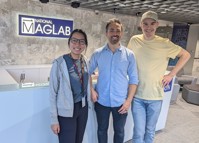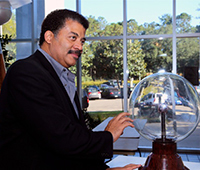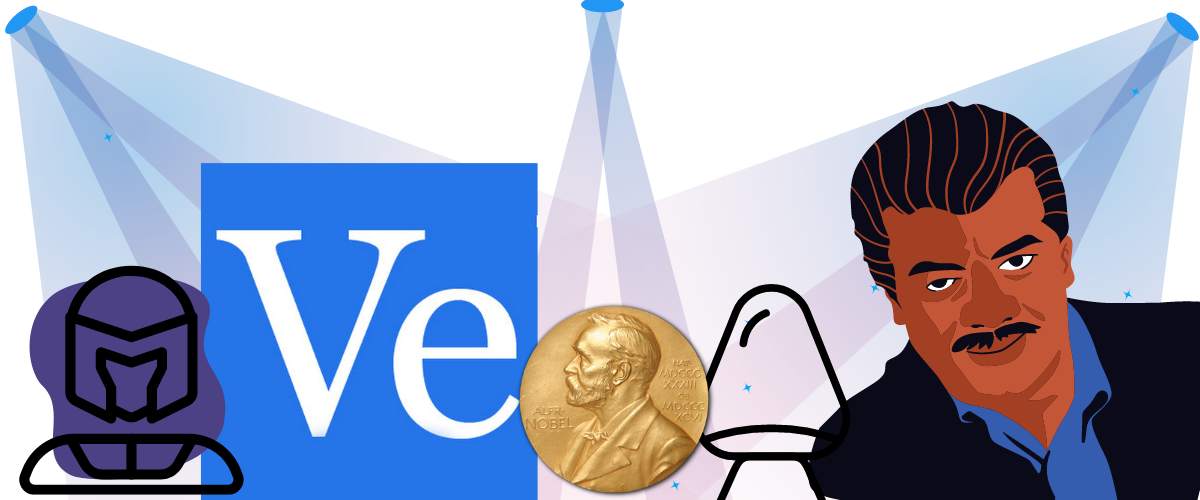The MagLab is filled with superstars.
From the more than a dozen one-of-a-kind world-record magnet systems to the brilliant physicists, biochemists, engineers, and technicians working in every hall, the MagLab, special spills from every space.
As the nation's monument to magnetism, sometimes actual celebrities even stop by.
YouTube science influencer Derek Muller and his Veritasium team recently strolled our halls of high field science to film some bizarre phenomenon propelled by powerful magnets.

The Veritasium team at the MagLab’s front desk.
They played with ferrofluid, a magnetic football, a giant metal plate, and other fun stuff in the stray fields of the world-record 45T magnet system and explored whether strong magnetic fields are safe for living things at our 900 MHz NMR magnet. They also levitated dice, pizza, strawberries, and even themselves during their visit! Watch for yourself!
Sir Ian McKellen, the actor who plays Magneto in the X-Men movies, came by the lab during a 2009 visit to the FSU Film School. After years of playing a powerful (and by many accounts, the coolest) mutant who has the ability to generate and control magnetic fields, a trip to the world's strongest magnet lab only makes sense. (No comment on whether the presence of Magneto-like superpowers were tested during his pop in).
One of the planet's best known physicists and science celebrity Neil DeGrasse Tyson has also toured the MagLab to learn about magnet making, high-field research, and even to hold court on what constitutes a good office chair.
Known for his ability to distill complex science into simple sentences, Tyson summarized the MagLab in six powerful words: “You do cool stuff with matter.“

Neil deGrasse Tyson in the MagLab’s atrium.
Tyson — who wanted to keep his lab visit low-key, small-scale and free of reporters — often surprised lab staff with his playful demeanor. At one point during the tour, he stopped and knocked on the door of an office cubby usually occupied by a MagLab postdoc. A startled graduate student was sitting in the seemingly run-of-the mill gray-colored office chair instead and had this memorable interaction explaining the power a good chair can have on science progress.
"See how this chair actually gives when you sink back in it? This chair was designed to conform to your body, not make your body conform to it. I had a chair like this when I was working on my doctoral thesis, and I never had any back problems from sitting in it for hours and hours because it was so well engineered."
The importance of good engineering turned out to be a central theme of his presentation — “Science as a Way of Knowing: A Cosmic Perspective” — to a packed house of nearly 1,200 people in FSU’s Ruby Diamond Concert Hall. After his visit to the MagLab, Tyson had seen some of the lab’s most cutting-edge magnet engineering projects, including the 45 T, the Split Coil 25 T and the 900 MHz and noted how many important discoveries, such as Magnetic Resonance Imaging (MRI) machines, grew out of basic research like that underway at the MagLab.
“In a hospital, every machine with an on/off switch that’s brought into the service of diagnosing the condition of your body without cutting you open is based on a principle of physics — and it was discovered by a physicist who had no interest in medicine at the time they made the discovery.”
Grandson of the famous Eames chair creators (of one of the most recognizable mid-century modern design pieces) Eames Demetrios was also inspired by MagLab engineering when he toured in 2013 during a visit to speak to students of FSU's Department of Interior Architecture + Design. He believed the MagLab's beautiful Florida bitter disks were a perfect illustration of his grandparents' philosophy that function is the primary element of design and made them a visual theme of his talk that evening.
The MagLab has also hosted its fair share of science luminaries. 1972 Physics Nobel Prize winner Bob Schrieffer was the lab's founding chief scientist and former FSU Chemistry Professor and 1996 Chemistry Nobel winner Harry Kroto was a frequent user of the lab's high field magnets. Horst Stormer, Dan Tsui, and Bob Laughlin (1998 Physics Nobel Winners), Duncan Haldane (2016 Physics), Richard Smalley (1996 Chemistry), and Eric Betzig (2014 Chemistry Nobel Winner) have all visited, taught, or performed research at the lab.
At the lab, we also believe our own MagLab users, researchers and staff are stars, yielding hundreds of publications each year that push science forward and make the world better for us all.
This story was originally published in Issue 10 of flux magazine, a discontinued publication of the National High Magnetic Field Laboratory.



